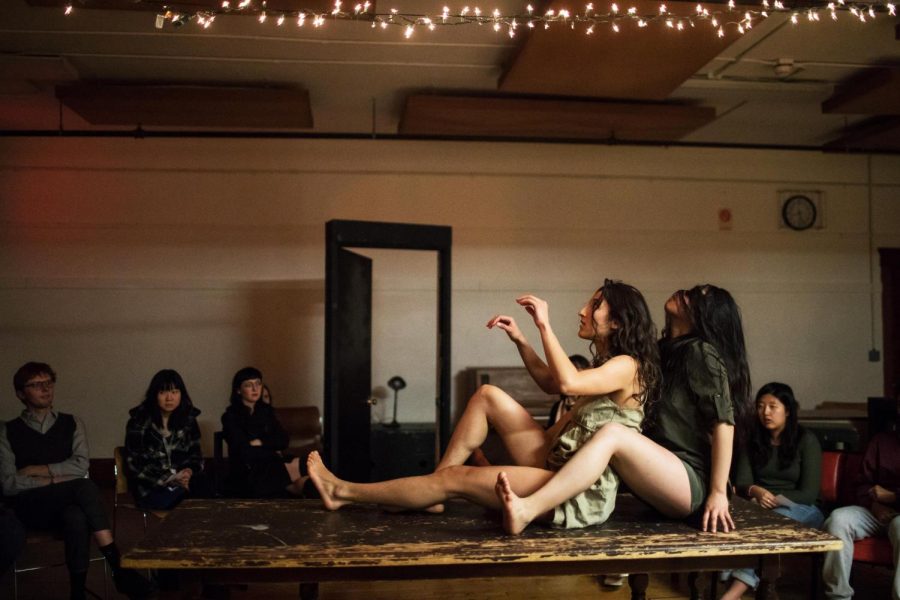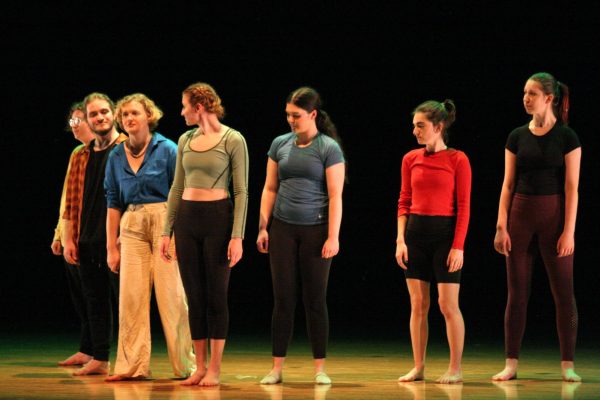Oberlin Dance Department Celebrates its Ranking Among Nation’s Top 25 Programs
Michal Schorsch, OC ’18, and College junior Kara Nepomuceno dance in last year’s Spring Back, one of the school’s semesterly faculty-run showcases.
In my junior year of high school, my lifelong dance teacher told me that she hoped there was a strong dance program wherever I chose to go to college, because she was sure I would miss it.
I nodded politely, sure she was wrong. During my college search, I barely considered dance — and yet, I spent much of my first semester at Oberlin rapturously watching dance, writing about dance, and fangirling over the pieces being created here and the amazing dancers doing the creating.
When I began to dance again in my second semester, then, it was unsurprising. I participated in a couple choreography projects, and felt thrown back into my body every time I set foot in Warner Main Space.
This semester, I took a movement class in the department for the first time. I’d thought I was done with dance, but dancing at Oberlin has made me fall more in love with it than ever.
When Onstage Blog released its annual college dance program rankings this August, Oberlin’s department (which last spring had just 16 majors and 15 minors) was among the country’s 25 best. Coming in at lucky number 13, Oberlin was highlighted for its emphasis on somatic studies, utilizing “both theoretical approaches and movement practices to increase kinesthetic awareness and an understanding of what creates optimal physical performance.”
Ann Cooper Albright, Chair of Oberlin’s Dance department, finds interdisciplinary scholarship invaluable.
“[Dance studies] is starting to blend [two things that] used to be much more distinct, which is scholarship and practice,” she said. “One of the things that’s great about our department is that all of the faculty teach across ideas.”
Nonetheless, it’s surprising to see Oberlin’s tiny department ranked among such esteemed programs as The Juilliard School, The Ailey School, and New York University’s Tisch School of the Arts. Unlike traditional dance conservatories, Oberlin does not outline specific technique requirements, nor does it require an audition to declare a major; the only required auditions are those determining placement in advanced technique classes. The lack of formal auditioning is easily perceived as a disconnect from the traditional standards of a good dance department, but more and more it seems to be a strength in producing passionate and self-directed dancers at Oberlin.
“We don’t have an ideal dancer that we’re trying to create,” Cooper Albright said. “What we have is a whole group of people just really curious about what is possible. It means that people who’ve never danced before and start dancing in college can major. It means that people who have lots and lots of experience outside of college can come in and grow. There are people in the department who end up majoring who would never have thought they’d major in dance. … We’re not really thinking about the answers. We’re really about forming the questions.”
In addition, Oberlin offers an array of classes in African and African diasporic dance forms each semester, including capoeira, West African dance, and samba. This variety in non-Western forms is highly unusual for a program of its size, and allows Oberlin’s dance department to cater to a range of student interests and cultivate exploration.
Visiting Assistant Professor of Dance Alice Blumenfeld joined the faculty this year teaching flamenco. Meiver de la Cruz, a Visiting Assistant Professor of Gender, Sexuality, and Feminist Studies, has taught Raqs Sharqi belly-dancing classes at Oberlin and will be receiving her doctorate in Performance Studies for a dissertation that is the first ethnographic history of Arab-American dance practices in the U.S.
College junior and Dance minor Rosemary Shin said that her ability to connect with faculty is one of the aspects of the program she treasures most.
“Because I’ve taken classes with almost all of them, I find that I’m close with each of the professors in different ways,” Shin said. “They create that environment.”
“My goal is to offer a program that is personalized, community-oriented, and relevant to the complexity of modern life,” wrote Assistant Professor of Dance Alysia Ramos in an email to the Review. “From [the various faculty and their expertise in different professional, scholarly, and choreographic areas] the students here get a rich and varied curriculum, personal mentoring and vital connections to the professional field. We also have wonderful facilities, opportunities for independent projects and collaborations with the conservatory that are unmatched in other programs.”
“I’m especially pleased that the department was graced by this outside recognition, because it will hopefully help validate our existence at a time when there is a sense of competition among Oberlin College departments for a shrinking pool of tenure track positions,” Cooper Albright said.
The interdisciplinary nature of Oberlin dance also makes it unique. Last year, despite the small number of majors, a remarkable 473 students enrolled in department courses.
“One of the things I always say is that I love the fact that the people in my classes aren’t just dance majors, that they also bring in their perspective for economics or neuroscience or English or a language,” Cooper Albright said. “This is [all] part of what we’re doing, and we’re not shutting that off.”
Even for those who have chosen to pursue dance more intensively at Oberlin, the ability to apply the discipline in a variety of ways is crucial.
“My dance work usually intersects other mediums like sculpture and film,” wrote College senior and Dance major Sophia Attebery in an email to the Review. In looking for college programs, Attebery was drawn to Oberlin’s “unconventional pedagogy compared to classical conservatory training.”
Zach Arfa, another junior Psychology major with a Dance minor, finds dance invaluable to his scientific pursuits.
“Whether [in] performance and virtuosity, choreography, tech, or community organizing, the dance department is structured to help students look past the artwork and be a little more inquisitive about the impact it actually has,” wrote Arfa in an email to the Review. “For me personally… I learn about people, how to change people’s perceptions and behaviors and what aspects of a project make something compelling and meaningful for someone; the same questions that psychologists ask in their research.”
Shin approaches things from a pre-med perspective.
“As someone who wants to be in the medical field, [Body Re-Education with Jennifer Shults] just changed my perspective on the body and health as a whole,” she said.
Contact Improvisation, the class that I’m currently taking, has done the same for me. I leave every class, no matter how exhausted or stressed I’ve been, feeling empowered. It’s made me think much more about our psychological relationship to touch, and about the courage it takes to depend on others through both connection and resistance. I’ve also been doing a whole bunch of handstands.
As Cooper Albright says, “Put the body in the world.” And that’s what I hope to do.











